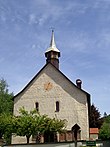Sitzenkirch monastery
The monastery Sitzenkirch was a small Benedictine monastery in Sitzenkirch in the district Lörrach . Today the former monastery church is the Evangelical Church of Sitzenkirch .
history
The first documentary mention as "Sitzenkirken" took place in 1120 in connection with the establishment of a Benedictine women's monastery , which was created on the basis of a donation by the local nobles of Kaltenbach to the monastery of St. Blasien at the time of the blessed abbot Rustenus . Ida von Kaltenbach and her daughter Himmeltrudis are named. Spiritual support was provided by the provost von Bürgeln .
The neighboring Gutnau Monastery was founded in 1181 with the help of a preserved inheritance , according to the news from the Liber Originum of Abbot Caspar Molitoris von Guta, a nun from the Sitzenkirch Monastery.
Sitzenkirch monastery and village fell victim to a feud between Rudolf I of Habsburg and the Bishop of Basel, Heinrich III. from Neuchâtel-Erguel . A fire destroyed the monastery to the ground, and parts of the place were also affected. The current church in Romanesque style was consecrated on January 12, 1277 with two altars by Auxiliary Bishop Inzeler in honor of Jesus Christ , Mary , Saints Hilary , Nicholas and Cycillia as well as Saints Benedict and Blaise. Another altar was donated by Queen Agnes of Hungary in 1305 , which stood on the west gallery and was reserved for the nuns. This altar, consecrated by the Basel Bishop of Basel in 1309, was consecrated to the 10,000 martyrs and St. Benedict. The church received a fourth altar in 1371, which was built by Margrave Otto (1302-1384) and his nephew Rudolf III. (1343–1428) was donated.
In the 13th and 14th centuries the monastery and the monastery church were used as the burial place of the Margraves of Hachberg-Sausenberg, whose ancestral seat, the Sausenburg , built around 1240, was not far from the monastery. Rudolf III. and Otto , donated the altar to the Holy Cross to the church in 1366 . Margrave Otto was buried in the church in Sitzenkirch in 1384. He and his relatives, Margrave Heinrich († 1318) and Margrave Hugo († 1448), who were also buried in the church, are remembered by tombstones adorned with coats of arms.
The monastery was incorporated into the monastery of St. Blasien in 1492 as an independent provost house . During the Peasants' War on May 3, 1525, the whole village and the monastery were devastated, only the church was spared. The nuns fled to Basel and did not return, the monastery of St. Blasien appointed a monastery brother as a conductor who administered the monastery property.
The church consecrated to St. Hilary is said to have been a chapel of Celtic Christians built in the 3rd century. The Celtic word sizen for "small" would allow the place name meaning "small church". The first written mention goes back to the year 1145. A deed of foundation of the then monastery in Sitzenkirch dated November 3, 1151 documents the handover to the monastery of St. Blasien. That was destroyed as a result of a war between several nobles against the Bishop of Basel and the city of Neuchâtel in 1272 and the church was badly damaged.
After a fire in 1493, two windows with simply profiled sandstone frames were created in the north and three in the south wall of the nave. In the following centuries, among other things due to the looting in the Peasants' War on May 3, 1525, the condition of the building deteriorated.
Web link
- Benedictine convent Sitzenkirch in the database of monasteries in Baden-Württemberg of the Baden-Württemberg State Archives
literature
- Johannes Helm: Churches and chapels in Markgräflerland , Müllheim / Baden 1989, ISBN 3-921709-16-4 , pp. 148-150.
- Franz Xaver Kraus : The art monuments of the Grand Duchy of Baden , Tübingen and Leipzig, 1901, fifth volume - Lörrach district; Pp. 144-147 online
- Columban Reble : Liber Originum Monasterij Sancti Blasij In Silva Hercynia: That is: An old-written book from the origin of the Gotts-Haus St. Blasien on the black forest . Waldshut, 1716, pp. 198-203 online
- Martin Gerbert : Historia Nigrae Silvae ordinis Sancti Benedicti coloniae , 1783–1788 (digital copies: Vol. 1 , Vol. 2 , Vol. 3 ), also published in German since 1993, translated by Adalbert Weh
Individual evidence
- ↑ later also Sizinkilchen and villa Sicinchilchen; s. Kraus p. 144
- ^ H. Trenkle: Local history of the communities Obereggenen and Sitzenkirch as well as the Provost Office Bürgeln , 1930, pp. 42–43
- ^ Fritz Schülin: Röttel-Haagen - Contributions to the local history and settlement history , Haagen 1965, p. 69.
- ↑ s. Karl Seith: The Markgräflerland and the Markgräfler in the Peasants' War of 1525. Karlsruhe 1926, p. 52
- ↑ since 1537 Bartholomäus Ramspach, who married the only remaining nun Dorothea Sebechin
- ^ H. Trenkle: Local history of the communities Obereggenen and Sitzenkirch as well as the Propstei Bürgeln , 1930, p. 36
- ^ E. Martini: Sitzenkirch in: Schau-ins-Land , 1876, p. 86
- ^ H. Trenkle: Local history of the communities Obereggenen and Sitzenkirch as well as the Propstei Bürgeln , 1930, p. 42
Coordinates: 47 ° 44 ′ 11.5 " N , 7 ° 40 ′ 22.3" E

